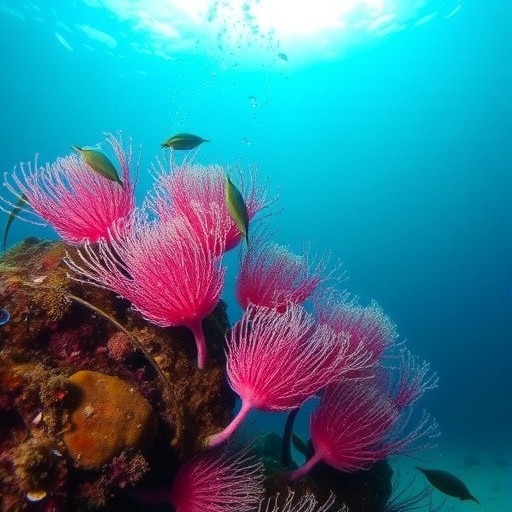In a groundbreaking study published in Coral Reefs, researchers have delved into the intricacies of reproductive phenology and sexual propagation of the pink sea fan, Eunicella verrucosa. This species, known for its delicate, branching form, has captured the interest of marine biologists and conservationists alike. With the ongoing threats posed by climate change and anthropogenic activities, understanding the reproductive strategies of such marine organisms is critical for informing restoration efforts in coral reef ecosystems.
The pink sea fan is not just another species in the vast ocean, but a vital component of its habitat, providing structure and sustenance to a myriad of marine life. The researchers focused on the timing of reproduction and the environmental factors influencing it. These dynamics play a pivotal role in the survival and resilience of marine populations, especially in the face of environmental stressors that have been on the rise in recent decades.
Through meticulous field studies, the team documented the seasonal patterns of gamete release and fertilization. They found that the reproductive period of Eunicella verrucosa occurs during specific windows in the year, significantly influenced by temperature variations and light availability. This revelation suggests that as climate conditions continue to fluctuate with global warming, the reproductive success of this species, and potentially other marine organisms, could be in jeopardy.
Moreover, the prospect of sexual propagation provides new hope for coral restoration initiatives. The ability of Eunicella verrucosa to reproduce sexually opens avenues for genetic diversity, which is essential for resilient populations. This genetic variability can enhance survival rates during environmental upheavals, enabling better adaptability and evolutionary responses to changing conditions. As restoration projects aim to reintroduce diversity into dwindling marine populations, leveraging the natural reproductive cycles of such species becomes increasingly important.
Equally fascinating is the role of sexual reproduction in increasing the overall viability of the species. The research disclosed that open populations of Eunicella verrucosa display varied reproductive strategies, which could imply a robust capability for resilience against environmental changes. This finding underscores the necessity for conservationists to consider the reproductive dynamics of marine species when developing restoration techniques.
Experiments in controlled environments alongside field observations highlighted the substantial impacts of reproductive health on larval recruitment. The data suggests that a successful reproductive event determines not just the immediate future of a species, but also sets the stage for longer-term ecological impacts. As larvae disperse and settle, they form the next generation, thus perpetuating the cycle of life crucial to maintaining biodiversity in marine ecosystems.
While significant attention is often directed towards coral species, this research reinforces the need to also acknowledge the ecological importance of soft corals. The structural complexity provided by Eunicella verrucosa contributes to habitat formation, offering refuge and resources to a host of marine organisms, from fishes to invertebrates.
In addition to reproductive strategies, the authors of this study also explored the potential impacts of human activity on Eunicella verrucosa. Overfishing, coastal development, and pollution have been linked to declines in marine biodiversity. This research acts as a clarion call to prioritize the protection of critical habitats, including those that house pink sea fans, thus ensuring that these vital ecosystems remain intact.
Furthermore, their findings have broader implications for the strategy of coral restoration. As ecosystems globally grapple with degradation, this research provides a framework from which to construct and deploy effective restoration methodologies. It highlights the necessity of timing and environmental conditions when initiating restoration efforts, notably those that involve sexual propagation of marine organisms.
Advancing the conversation, the researchers advocate for integrated approaches that combine scientific research with community engagement. Involving local stakeholders, including fishermen and conservation organizations, could bolster conservation initiatives, creating a sense of shared responsibility and collective action towards sustaining marine biodiversity.
In conclusion, the comprehensive examination of the reproductive phenology of Eunicella verrucosa represents a significant contribution to our understanding of marine ecology and conservation. The implications of this research extend beyond academic interest; they speak to urgent conservation needs and reveal pathways for effective restoration strategies that could aid in the recovery of coral reef ecosystems worldwide.
As our planet faces an unprecedented environmental crisis, studying organisms such as the pink sea fan may hold the key to unraveling solutions to some of the most critical challenges posed by climate change. Thus, ongoing research and proactive conservation measures will be paramount in ensuring future generations can also experience the beauty and diversity of these marine ecosystems.
The urgency of addressing the ecological crises we face today cannot be overstated. By learning from the reproductive processes of marine species, we can not only understand their biology better but also apply this knowledge to broader conservation efforts. In doing so, we create a hopeful narrative about the resilience of marine life and the possibility for restoration amidst global environmental changes.
With communities increasingly recognizing the necessity of preserving marine biodiversity, the dialogue initiated by this research may well inspire collaborative efforts towards more sustainable practices. The findings concerning Eunicella verrucosa illustrate that while human impacts have been detrimental, there remains an opportunity for recovery through informed action, guided by the insights gleaned from this vital research.
Thus, as eyes turn toward the ocean’s depths, the pink sea fan stands not merely as another species but as a beacon of hope for marine conservation. Understanding and protecting its reproductive health holds promise not just for the future of this particular species but for the entire marine ecosystem it supports.
Subject of Research: Reproductive phenology and sexual propagation of the pink sea fan Eunicella verrucosa
Article Title: Reproductive phenology and sexual propagation of the pink sea fan Eunicella verrucosa (Pallas, 1766): implications for coral restoration.
Article References:
Egger, C., Melo, C., Marquardt, B. et al. Reproductive phenology and sexual propagation of the pink sea fan Eunicella verrucosa (Pallas, 1766): implications for coral restoration. Coral Reefs (2025). https://doi.org/10.1007/s00338-025-02705-x
Image Credits: AI Generated
DOI:
Keywords: Coral reefs, Eunicella verrucosa, reproductive phenology, sexual propagation, marine conservation, restoration ecology.




